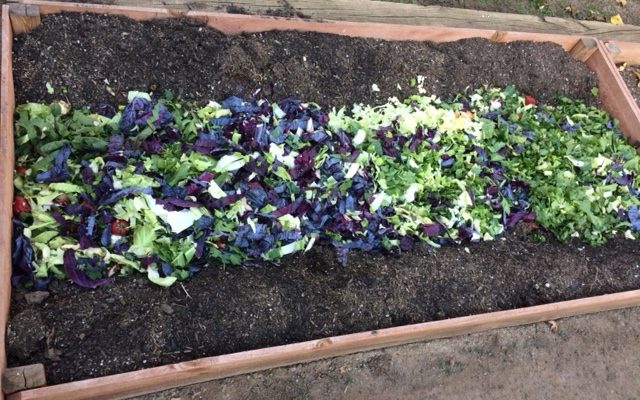Direct Composting
I am adding large amounts of vegetable waste directly into the dirt of my raised beds. Why? Well, my dirt is bad, I mean really bad. When I turn it I still see lumps that appear to be rocks, so I go to pull them out. Then I discover it is just a lump of compacted dirt, so I squish it with my hands, or if too hard I pound it with my shovel and it breaks up into this dry powder, some of which flies away into the air.
We are in the month of December, and I have already lost time with planting some of my intended winter crop. Although we did begin direct composting the last week of September in four raised beds that were free of things growing and producing crop. So over the course of the last two months we have direct composted now in eight beds. And at this moment I have twelve beds of direct composting going. Two raised beds now have crops going and I quickly need to get crops in at least four more raised beds.
So how am I able to do this? In September I researched all the farmer’s markets that occur in and around my area. There are four, but one is on a week-night and just not convenient at all, so that one was ruled out. I then started going there before they closed up for the day. They all close at 1pm. I quickly found out that if I got there at 12:30pm that I was too late. If the farmers have sold everything they will leave earlier than closing time. Also, there is a lot of stuff they carry with them, it takes time to put away, so they start putting away and cleaning up as early as 12:00pm. For me the perfect time is 11:30am. It seems that they have had enough customers to start accumulating boxes of compost waste and they have not started loading anything into their trucks for the day yet.
How did I collect their compost waste? Well I already had a wheeled hand cart that I used previously for laundry when we lived in an apartment. I lined that with cardboard and secured the front and back cardboard lining with zip ties. I also made cardboard for the sides, but did not secure it so that I can pull it out and close up the cart if I need to. I then lined the inside with a large black garbage bag. TEST THAT THE BAGS FIT AT HOME FIRST!!!!!! On my second trip out, I accidently grabbed garbage bags that were too small and that trip did not end very well. I actually line the basket with two garbage bags, one placed inside of the other one, as this helps me when we are trying to pull out very heavy bags (i.e. if someone gave you fruit). When I have gone around and collected compost waste and I think my bag is heavy enough or it is very full, I take that to the car and pull out the inner plastic bag only. I then line the basket again with a second bag and repeat my rounds until I have asked all the stands. Typically I ask: ‘Do you have any compost, vegetable waste you are getting rid of?’
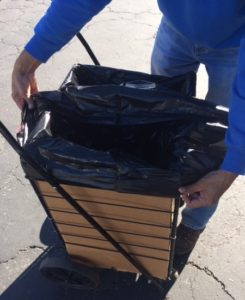
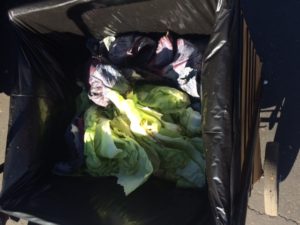
In the beginning I was going to all three farmer’s markets. They had one on Saturday and two on Sunday in my area. However, I began noticing that I might only get one bag from a particular farmer’s market each time I went there. Also, the bigger farmer’s market with more stands seemed to have not as welcoming a response than the smaller one. I would normally get about three bags on average from the biggest farmer’s market. It was actually the smallest farmer’s market that I got the most vegetable waste from, and they were the nicest. That was the only place I heard ‘Oh, I sure hope you come every week, then I don’t have to lug all this back.’ And ‘I will start saving this for you.’ So now, this is the only one I go to and on average I come back with about five bags. Sometimes three bags are collected and sometimes six bags.
Bags are loaded in the car:
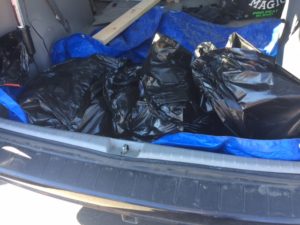
At home I prepare the raised bed for the compost by digging a concave, so there is a good size depression in the middle:
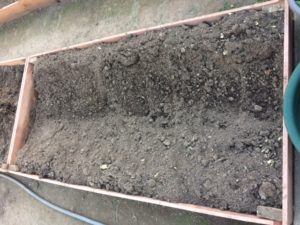
Then we coarsely chop up the vegetables into a bucket and dump the bucket directly into the prepared raised bed.

You then take the dirt from the sides, and pull it up over the compost to cover it completely. I normally pull the dirt over on one side, then walk to the other side of the bed and do the other side. It will then form a small mound shape.
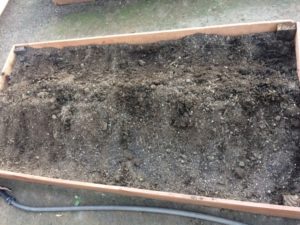
You will want to water the bed occasionally over the next 2-weeks. It should be slightly moist, but not water-logged. If it rains, it rains, I don’t worry about it.
After 2-weeks I completely turn the bed with my shovel. Just picking the dirt up and turning it until I have given it all a good turn and worked in the sides of the dirt into the middle a little bit. Then I make sure none of the compost is exposed; so all should still be covered with dirt.
In two more weeks, you will want to turn the bed with your shovel again. Only this time, you should see very little compost remaining. It should mostly be turned into dirt now and you should see more earthworms in your bed. At this point, when there is very little compost to be seen, you can either plant in the beds now, or you can do another direct composting cycle.
Here is a video if it is more helpful to see. But I did not mention in the video to water it occasionally during those 4-weeks, so remember to do that:
Happy composting! :]

